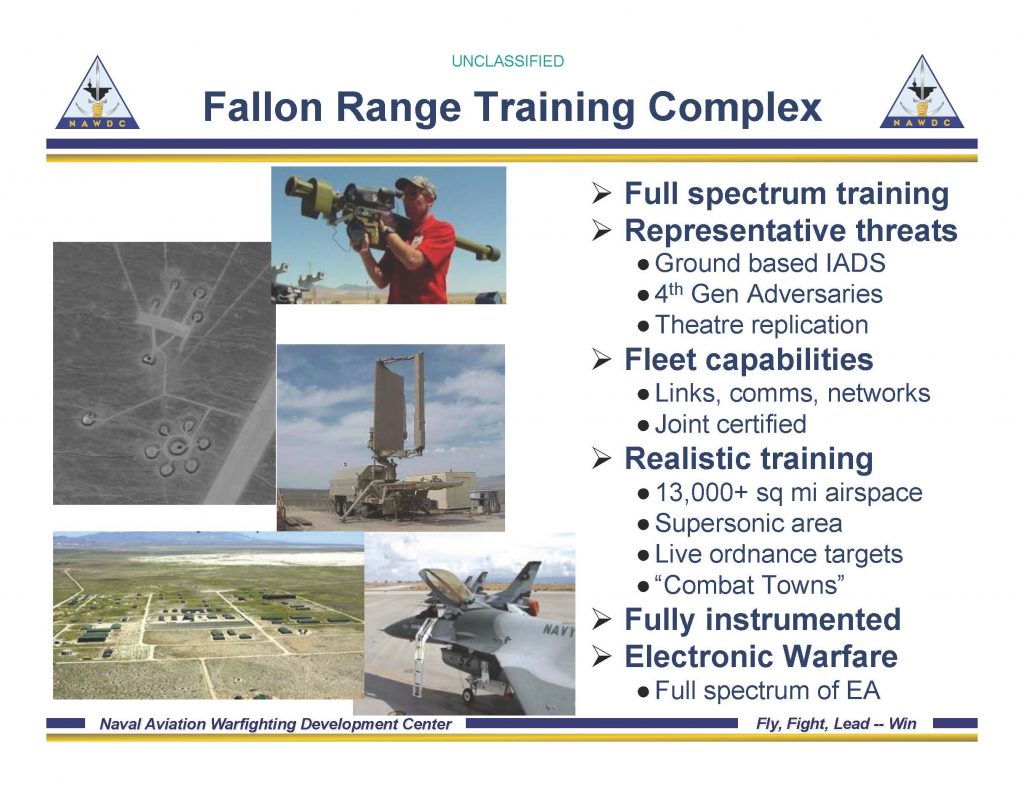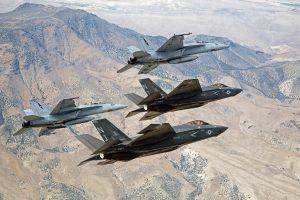2017-08-16 By Robbin Laird and Ed Timperlake
During our visit to NAWDC, we had a chance to talk with Captain Enfield, an experienced naval aviator with several tours of duty in Japan and Pete Milham, the NAWDC Technical Director.
We discussed with them the evolution of NAWDC to build out capabilities to work within an expanded battlespace and to drive the process of enhanced integration of the air enabled naval force.
The senior leadership has suggested that the strategic goal of a distributed but integrated force is to be able to operate as a kill web.
The kill chain is a linear concept which is about connecting assets to deliver fire power; the kill web is about distributed operations and the ability of force packages or task forces to deliver force dominance in an area of interest.
It is about building in integration from the ground up so that forces can work seamlessly together through multiple networks, rather than relying on a single point of failure large network.
https://sldinfo.com/rear-admiral-manazir-in-australia-allied-convergence-on-the-kill-web/
But the kill web remains a concept if the technology and training do not translate into operational realities.
Most often, the technology is discussed in this context; but the training is crucial to shape a way for naval aviators to operate as animators of an integrated kill web.
“Doogie” is a very experienced combat aviator put his focus squarely on the need for vigilance and diligence to refocus the current acquisition process to always make sure “state-of-the art” technology is rapidly fielded and in the hands of warriors when it really matters.
“We have a very slow acquisition process.
“Other countries do not.
“Other countries are beginning to rival us with their intellectual capability.
“We must leverage ever more effective training for integrated operations and to develop the TPPs that allow us to prevail in combat.”
There are a number of tools being put in place to provide for the evolution of more effective integrated operations from the ground up or put another way, to train for operating as a kill web requires a new tool set.
This is a key task facing NAWDC.

Fallon is known as the Carrier in the Desert; but as the carrier and its role within the fleet evolve and encompass distributed lethality and the kill web, so must the Carrier in the Desert evolve.
It starts with the addition of two new buildings, which embrace the shift.
One building is to house the integrated air enabled force; the second houses the simulators that drive the process of their integration.
The first building, building P420, will house the integrated training effort.
“The entire building is a SCIF (Sensitized Compartmented Information Facility) at 55,000 square feet.
“We will have offices in there.
‘We will have auditoriums.
‘We will have classrooms.
‘We will have mission-planning rooms.
‘And the building will also house the spaces from which we monitor and control missions on the Fallon Range.
“We will be able to do all of our operations at the appropriate classification level for the entire air wing.”
The additional new building will house the simulators.
“Building P440, which is 25,000 square feet, will host initially the simulator devices for the integrated training facility.
 150903-N-SS390-266 FALLON, Nev. (Sept. 3, 2015) F-35C Lightning IIs, attached to the Grim Reapers of Strike Fighter Squadron (VFA) 101, and an F/A-18E/F Super Hornets attached to the Naval Aviation Warfighter Development Center (NAWDC) fly over Naval Air Station Fallon’s (NASF) Range Training Complex. VFA 101, based out of Eglin Air Force Base, is conducting an F-35C cross-country visit to NASF. The purpose is to begin integration of F-35C with the Fallon Range Training Complex and work with NAWDC to refine tactics, techniques and procedures (TTP) of F-35C as it integrates into the carrier air wing. (U.S. Navy photo by Lt. Cmdr. Darin Russell/Released)
150903-N-SS390-266 FALLON, Nev. (Sept. 3, 2015) F-35C Lightning IIs, attached to the Grim Reapers of Strike Fighter Squadron (VFA) 101, and an F/A-18E/F Super Hornets attached to the Naval Aviation Warfighter Development Center (NAWDC) fly over Naval Air Station Fallon’s (NASF) Range Training Complex. VFA 101, based out of Eglin Air Force Base, is conducting an F-35C cross-country visit to NASF. The purpose is to begin integration of F-35C with the Fallon Range Training Complex and work with NAWDC to refine tactics, techniques and procedures (TTP) of F-35C as it integrates into the carrier air wing. (U.S. Navy photo by Lt. Cmdr. Darin Russell/Released)
“These include F-35, E-2D, Super Hornet, Growler, and Aegis.”
But this is a work in progress, as all simulators do not seamlessly connect, although this is a clear requirement going forward.
For example, “there is no MH-60R simulator that connects easily to other simulators.”
The software side is important as well as the simulators will be upgraded to the state of the fleet software for each platform and the different software builds resident in the fleet as well can be leveraged for each platform.
The software enablement of the new platforms clearly puts a premium on collocating code writers with operators and TTP writers, but this is a work in progress.
But to get the kind of on the fly kind of integration, which will enhance combat success, this transition needs to be made, executed and then evolved.
The ability to shape the virtual training environment is a key focus of attention and needs to be integrated prior to doing the much more difficult part, namely folding in the live aspect of a training mission.
In short, at NAWDC the team is a key part of shaping the way ahead to forge a maritime force able to operate as a kill web.
Editor’s note: The Navy is looking to expand the size of the training range.
Integrated ops training extends the need for larger range space for certain.
According to a September 2, 2016 article by Steve Timko, the Navy is looking to quadruple land for Fallon naval Air Station training.
FALLON, Nev. (KOLO)– The Fallon Naval Air Station will increase public land used for training by about four times to about 1,262 square miles under a proposal released this week.
The U.S. Navy is asking for an additional 604,789 acres and to renew the use of 202,859 acres. It scheduled seven meetings in Nevada to discuss the proposal, including Oct. 3 in Fallon and Oct. 4 in Reno.
The Navy said it began reviewing its training ability at the Fallon Naval Air Station in 2014.
“The analysis showed that the size of the Fallon Ranges severely restricts the types of weapons that can be used, which limits training realism and effectiveness,” it wrote. “These limitations leave aircrews and special operations forces unable to fully train, compromising their safety and success in combat.”
Newer aircraft require more training space, the Navy said.
“The boundaries of the Fallon Ranges have not changed to accommodate for the capabilities of modern weapons,” the Navy wrote. “Modern weapons can reach targets at greater distances than ever before, but current range boundaries limit this type of training. Expanding the range boundaries would allow military personnel to train in a realistic, and in some instances 360-degree, combat scenario.”
So it is asking for additional land. Congress must sign off on expanding the land used by the base. It appears it will involve buying privately owned land, for which the Navy said it will offer fair-market price.
Churchill County Manager Eleanor Lockwood said the base, which has a good relationship with the county, first notified them of the proposal on Aug. 26. Churchill County commissioners are scheduled to formally review the proposal at its Sept. 21 meeting and they are expected to have it reviewed by Resource Concept Inc. of Carson City, which is under contract to the county to review these kinds of studies.
RCI is expected to help Churchill County understand impact the expansion has, Lockwood said. For example, what restrictions will be imposed on the land for recreation, ranching or mining.
She called it the first major expansion of the military range.
Churchill County Commissioner Harry “Bus” Scharmann is looking forward to getting more information about the proposed expansion.
“We want to look at this closely,” Scharmann said. “The Navy and Churchill County have been good partners and we always try to work closely with them.”
According to the information provided by the Navy, the base contributed $517 million in economic activity in a three-county area in 2015 and had a payroll of $84 million.
“The base is huge. That’s how I put it,” Scharmann said. “Our economy centers around the Navy base and agricultural.
“In my mind, in the last seven years when we have had a drought and a slowdown in the economy, the thing that has been a major stabilizing factor has been the Navy base,” Scharmann said.

